Classical period (c. 200 BCE – c. 650 CE)
The time between the Maurya Empire in the 3rd century BCE and the end of the Gupta Empire in the 6th century CE is referred to as the "Classical" period of India.[137] It can be divided in various sub-periods, depending on the chosen periodisation. Classical period begins after the decline of the Maurya Empire, and the corresponding rise of the Shunga Empire and Satavahana dynasty. The Gupta Empire (4th–6th century) is regarded as the "Golden Age" of Hinduism, although a host of kingdoms ruled over India in these centuries. Also, the Sangam literature flourished from the 3rd century BCE to the 3rd century CE in southern India.[7] During this period, India's economy is estimated to have been the largest in the world, having between one-third and one-quarter of the world's wealth, from 1 CE to 1000 CE.[138][139]
Early classical period (c. 200 BCE – c. 320 CE)
Shunga Empire
The Shungas originated from Magadha, and controlled large areas of the central and eastern Indian subcontinent from around 187 to 78 BCE. The dynasty was established by Pushyamitra Shunga, who overthrew the last Maurya emperor. Its capital was Pataliputra, but later emperors, such as Bhagabhadra, also held court at Vidisha, modern Besnagar in Eastern Malwa.[140]
Pushyamitra Shunga ruled for 36 years and was succeeded by his son Agnimitra. There were ten Shunga rulers. However, after the death of Agnimitra, the empire rapidly disintegrated;[141] inscriptions and coins indicate that much of northern and central India consisted of small kingdoms and city-states that were independent of any Shunga hegemony.[142] The empire is noted for its numerous wars with both foreign and indigenous powers. They fought battles with the Mahameghavahana dynasty of Kalinga, Satavahana dynasty of Deccan, the Indo-Greeks, and possibly the Panchalas and Mitras of Mathura.
Art, education, philosophy, and other forms of learning flowered during this period including small terracotta images, larger stone sculptures, and architectural monuments such as the Stupa at Bharhut, and the renowned Great Stupa at Sanchi. The Shunga rulers helped to establish the tradition of royal sponsorship of learning and art. The script used by the empire was a variant of Brahmi and was used to write the Sanskrit language. The Shunga Empire played an imperative role in patronising Indian culture at a time when some of the most important developments in Hindu thought were taking place. This helped the empire flourish and gain power.
Satavahana Empire
The Śātavāhanas were based from Amaravati in Andhra Pradesh as well as Junnar (Pune) and Prathisthan (Paithan) in Maharashtra. The territory of the empire covered large parts of India from the 1st century BCE onward. The Sātavāhanas started out as feudatories to the Mauryan dynasty, but declared independence with its decline.
The Sātavāhanas are known for their patronage of Hinduism and Buddhism, which resulted in Buddhist monuments from Ellora (a UNESCO World Heritage Site) to Amaravati. They were one of the first Indian states to issue coins struck with their rulers embossed. They formed a cultural bridge and played a vital role in trade as well as the transfer of ideas and culture to and from the Indo-Gangetic Plain to the southern tip of India.
They had to compete with the Shunga Empire and then the Kanva dynasty of Magadha to establish their rule. Later, they played a crucial role to protect large part of India against foreign invaders like the Sakas, Yavanas and Pahlavas. In particular, their struggles with the Western Kshatrapas went on for a long time. The notable rulers of the Satavahana Dynasty Gautamiputra Satakarni and Sri Yajna Sātakarni were able to defeat the foreign invaders like the Western Kshatrapas and to stop their expansion. In the 3rd century CE the empire was split into smaller states.[143]
Trade and travels to India
- The spice trade in Kerala attracted traders from all over the Old World to India. Early writings and Stone Age carvings of Neolithic age obtained indicates that India's Southwest coastal port Muziris, in Kerala, had established itself as a major spice trade centre from as early as 3,000 BCE, according to Sumerian records. Jewish traders from Judea arrived in Kochi, Kerala, India as early as 562 BCE.[144]
- Buddhism entered China through the Silk Road transmission of Buddhism in the 1st or 2nd century CE. The interaction of cultures resulted in several Chinese travellers and monks to enter India. Most notable were Faxian, Yijing, Song Yun and Xuanzang. These travellers wrote detailed accounts of the Indian subcontinent, which includes the political and social aspects of the region.[145]
- Hindu and Buddhist religious establishments of Southeast Asia came to be associated with the economic activity and commerce as patrons entrust large funds which would later be used to benefit the local economy by estate management, craftsmanship, promotion of trading activities. Buddhism in particular, travelled alongside the maritime trade, promoting coinage, art, and literacy.[146] Indian merchants involved in spice trade took Indian cuisine to Southeast Asia, where spice mixtures and curries became popular with the native inhabitants.[147]
- The Greco-Roman world followed by trading along the incense route and the Roman-India routes.[148] During the 2nd century BCE Greek and Indian ships met to trade at Arabian ports such as Aden.[149] During the first millennium, the sea routes to India were controlled by the Indians and Ethiopians that became the maritime trading power of the Red Sea.
Kushan Empire
The Kushan Empire expanded out of what is now Afghanistan into the northwest of the Indian subcontinent under the leadership of their first emperor, Kujula Kadphises, about the middle of the 1st century CE. The Kushans were possibly of Tocharian speaking tribe;[150] one of five branches of the Yuezhi confederation.[151][152] By the time of his grandson, Kanishka the Great, the empire spread to encompass much of Afghanistan,[153] and then the northern parts of the Indian subcontinent at least as far as Saketa and Sarnath near Varanasi (Banaras).[154]
Emperor Kanishka was a great patron of Buddhism; however, as Kushans expanded southward, the deities of their later coinage came to reflect its new Hindu majority.[155][156] They played an important role in the establishment of Buddhism in India and its spread to Central Asia and China.
Historian Vincent Smith said about Kanishka:
The empire linked the Indian Ocean maritime trade with the commerce of the Silk Road through the Indus valley, encouraging long-distance trade, particularly between China and Rome. The Kushans brought new trends to the budding and blossoming Gandhara art and Mathura art, which reached its peak during Kushan rule.[158]
H.G. Rowlinson commented:
By the 3rd century, their empire in India was disintegrating and their last known great emperor was Vasudeva I.[160][161]
Classical period (c. 320 – 650 CE)
Gupta Empire
The Gupta period was noted for cultural creativity, especially in literature, architecture, sculpture, and painting.[162] The Gupta period produced scholars such as Kalidasa, Aryabhata, Varahamihira, Vishnu Sharma, and Vatsyayana who made great advancements in many academic fields. The Gupta period marked a watershed of Indian culture: the Guptas performed Vedic sacrifices to legitimise their rule, but they also patronised Buddhism, which continued to provide an alternative to Brahmanical orthodoxy. The military exploits of the first three rulers – Chandragupta I, Samudragupta, and Chandragupta II – brought much of India under their leadership.[163] Science and political administration reached new heights during the Gupta era. Strong trade ties also made the region an important cultural centre and established it as a base that would influence nearby kingdoms and regions in: Sri Lanka; Maritime Southeast Asia (Brunei, Indonesia, Malaysia, Philippines, Singapore, and Timor-Leste);[164] as well as Indochina (Cambodia, Laos, Myanmar, Thailand, and Vietnam).[165]
The latter Guptas successfully resisted the northwestern kingdoms until the arrival of the Alchon Huns, who established themselves in Afghanistan by the first half of the 5th century CE, with their capital at Bamiyan.[166] However, much of the southern India including Deccan were largely unaffected by these events in the north.[167][168]
Vakataka Empire
The Vākāṭaka Empire originated from the Deccan in the mid-third century CE. Their state is believed to have extended from the southern edges of Malwa and Gujarat in the north to the Tungabhadra River in the south as well as from the Arabian Sea in the western to the edges of Chhattisgarh in the east. They were the most important successors of the Satavahanas in the Deccan, contemporaneous with the Guptas in northern India and succeeded by the Vishnukundina dynasty.
The Vakatakas are noted for having been patrons of the arts, architecture and literature. They led public works and their monuments are a visible legacy. The rock-cut Buddhist viharas and chaityas of Ajanta Caves (a UNESCO World Heritage Site) were built under the patronage of Vakataka emperor, Harishena.[169][170]
Kamarupa Kingdom
Samudragupta's 4th-century Allahabad pillar inscription mentions Kamarupa (Western Assam)[171] and Davaka (Central Assam)[172] as frontier kingdoms of the Gupta Empire. Davaka was later absorbed by Kamarupa, which grew into a large kingdom that spanned from Karatoya river to near present Sadiya and covered the entire Brahmaputra valley, North Bengal, parts of Bangladesh and, at times Purnea and parts of West Bengal.[173]
Ruled by three dynasties Varmanas (c. 350–650 CE), Mlechchha dynasty (c. 655–900 CE) and Kamarupa-Palas (c. 900–1100 CE), from their capitals in present-day Guwahati (Pragjyotishpura), Tezpur (Haruppeswara) and North Gauhati (Durjaya) respectively. All three dynasties claimed their descent from Narakasura, an immigrant from Aryavarta.[174] In the reign of the Varman king, Bhaskar Varman (c. 600–650 CE), the Chinese traveller Xuanzang visited the region and recorded his travels. Later, after weakening and disintegration (after the Kamarupa-Palas), the Kamarupa tradition was somewhat extended until c. 1255 CE by the Lunar I (c. 1120–1185 CE) and Lunar II (c. 1155–1255 CE) dynasties.[175] The Kamarupa kingdom came to an end in the middle of the 13th century when the Khen dynasty under Sandhya of Kamarupanagara (North Guwahati), moved his capital to Kamatapur (North Bengal) after the invasion of Muslim Turks, and established the Kamata kingdom.[176]
Pallava Empire
The Pallavas, during the 4th to 9th centuries were, alongside the Guptas of the North, great patronisers of Sanskrit development in the South of the Indian subcontinent. The Pallava reign saw the first Sanskrit inscriptions in a script called Grantha.[177] Early Pallavas had different connexions to Southeast Asian countries. The Pallavas used Dravidian architecture to build some very important Hindu temples and academies in Mamallapuram, Kanchipuram and other places; their rule saw the rise of great poets. The practice of dedicating temples to different deities came into vogue followed by fine artistic temple architecture and sculpture style of Vastu Shastra.[178]
Pallavas reached the height of power during the reign of Mahendravarman I (571–630 CE) and Narasimhavarman I (630–668 CE) and dominated the Telugu and northern parts of the Tamil region for about six hundred years until the end of the 9th century.[179]
Kadamba Empire
Kadambas originated from Karnataka, was founded by Mayurasharma in 345 CE which at later times showed the potential of developing into imperial proportions, an indication to which is provided by the titles and epithets assumed by its rulers. King Mayurasharma defeated the armies of Pallavas of Kanchi possibly with help of some native tribes. The Kadamba fame reached its peak during the rule of Kakusthavarma, a notable ruler with whom even the kings of Gupta Dynasty of northern India cultivated marital alliances. The Kadambas were contemporaries of the Western Ganga Dynasty and together they formed the earliest native kingdoms to rule the land with absolute autonomy. The dynasty later continued to rule as a feudatory of larger Kannada empires, the Chalukya and the Rashtrakuta empires, for over five hundred years during which time they branched into minor dynasties known as the Kadambas of Goa, Kadambas of Halasi and Kadambas of Hangal.
Empire of Harsha
Harsha ruled northern India from 606 to 647 CE. He was the son of Prabhakarvardhana and the younger brother of Rajyavardhana, who were members of the Vardhana dynasty and ruled Thanesar, in present-day Haryana.
After the downfall of the prior Gupta Empire in the middle of the 6th century, North India reverted to smaller republics and monarchical states. The power vacuum resulted in the rise of the Vardhanas of Thanesar, who began uniting the republics and monarchies from the Punjab to central India. After the death of Harsha's father and brother, representatives of the empire crowned Harsha emperor at an assembly in April 606 CE, giving him the title of Maharaja when he was merely 16 years old.[181] At the height of his power, his Empire covered much of North and Northwestern India, extended East until Kamarupa, and South until Narmada River; and eventually made Kannauj (in present Uttar Pradesh state) his capital, and ruled until 647 CE.[182]
The peace and prosperity that prevailed made his court a centre of cosmopolitanism, attracting scholars, artists and religious visitors from far and wide.[182] During this time, Harsha converted to Buddhism from Surya worship.[183] The Chinese traveller Xuanzang visited the court of Harsha and wrote a very favourable account of him, praising his justice and generosity.[182] His biography Harshacharita ("Deeds of Harsha") written by Sanskrit poet Banabhatta, describes his association with Thanesar, besides mentioning the defence wall, a moat and the palace with a two-storied Dhavalagriha (White Mansion).[184][185]
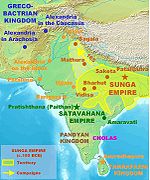


![Relief of a multi-storied temple, 2nd century CE, Ghantasala Stupa.[135][136]](https://upload.wikimedia.org/wikipedia/commons/thumb/7/75/Andhra_pradesh%2C_santuario_a_pi%C3%B9_piani%2C_da_ghantasala%2C_90-110_ca..JPG/160px-Andhra_pradesh%2C_santuario_a_pi%C3%B9_piani%2C_da_ghantasala%2C_90-110_ca..JPG)






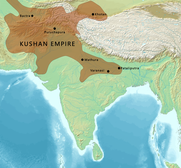






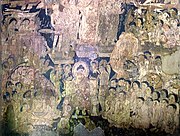

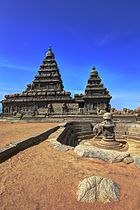

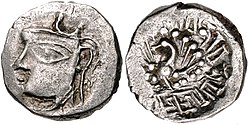
Comments
Post a Comment